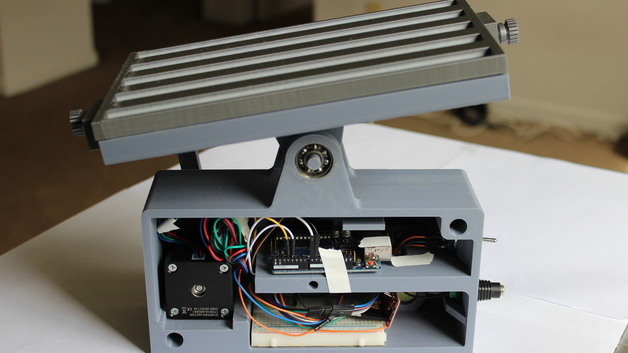Lab equipment is often expensive, but budgets can be tight and not always up to getting small labs or researchers what they need. That’s why [akshay_d21] designed an Open Source Lab Rocker with a modular tray that uses commonly available hardware and 3D printed parts. The device generates precisely controlled, smooth motion to perform automated mild to moderately aggressive mixing of samples by tilting the attached tray in a see-saw motion. It can accommodate either a beaker or test tubes, but since the tray is modular, different trays can be designed to fit specific needs.
Source code and schematics are available from [akshay_d21]’s Google Drive and the 3D models are also available from the National Institute of Health’s 3D Print Exchange. A demonstration video is embedded below, in which you can see how smooth and controlled the motions are.
DIY lab equipment really benefits from the recent growth in desktop manufacturing and part availability; this one is in good company along with the DIY Laboratory Dry Bath and this DIY Syringe Pump.
















Wonder why they went with a rocker rather than a shaker.
Different actions, shakers are good for mixing liquids but sometimes you want to wash liquids relatively evenly over something like a gel which is lying flat. Rocking can mix and wash some things much more thoroughly at relatively more gentle speeds.
A good example is etching a PCB.
Shaking it may leave local spots of worn out etchant, but rocking waves over the etchant bath washes out local exhausted etchant.
An open bath also can’t be shaken too hard or the etchant will slodge over the edge, while gently rocking will cause a nice flow / mixing by generating an etchant flow from left to right and back.
The clinical lab where i used to work had automatic rockers and stirrers. Shaking was done by hand.
I mean an orbital shaker that swirls flasks, not something like a paint shaker. Orbital shakers are used (or at least that’s how we used them) for culturing liquid media.
As someone that works in the bio instrument field, I am waiting for the inevitable person to ask about the rpm and if it has an orbital mode.
Here’s an oldie-but-goodie in the same vein .. https://makezine.com/2010/12/06/diy-laboratory-shaker/
Why is the motor wheel offset from where it connects to the platform? It bothers me that it rocks longer on one side than the other
Completely agree. Also the video and hype is a bit of an overkill for a rocker table lol
hype ?!?! overkilll?!?! But… but… this things rocks dude!
But seriously… it doesn’t rock as smooth as I expected it.
And what surprises me the most is that the electronics inside (that have more computing power then the rocket that shot some guys to the moon) it is only used to control the speed of the motor.
What a waste. And needlessly complicated.
The stepper was used to turn a wheel that creates the rocking motion, but if the motor was connected more directly to the platform then the motion could be completely controlled by making the motor move in 2 direction modulated like a sinewave. For slow microcontrollers even a simple table holding the steps vs time could do the trick. Creating the rock completely by the motor instead of the circular to linear mechanical solution.
However the uneven rock movement caused by the incorrect alignment of the arms (move motor position or lengthen the arm) of the rock could still be corrected in the same way.
In other words, this design could still be simplified and perfectly by the power of firmware, you already have that power in your machine… now go and use it wisely my friend.
Didn’t we just see this the other day, and I agree, it does not rock smoothly at all. It looks like if you shut it off in the wrong position it may not restart. Not bad for a first stab, but I would not call it a near finished project.
Sometimes it’s beneficial to mix and at the same time allow heavier sediment to precipitate out to one end, so an uneven rocking motion would, under those circumstances that least, be somewhat useful. Although I should imagine that at higher rates of oscillation, the lack of symmetry would not have any real hysteresis like effect on the moment of the contents.
why use stepper instead of normal 5 or 12V motor?
on a 2nd thought, with stepper you can control the rocking angle w/o any mechanical adjustment
I’d still vastly prefer the simplicity of an adjustable linkage and a dc motor with no control circuitry whatsoever instead of microcontroller and stepper motor, at least for something so simple
Kudos on the crafting. But my buddy McGyver over here also agrees on the over engineering. Hes gotta gerbil, toilet paper tube, and a pencil rockn his mixtures.
Great project! People are making opensource lab equipment. Whatever flaws it might have are open for us all to improve on as a community.
FYI, commercial laboratory rocker/shakers like GE’s Wave Bioreactor are used in cutting edge biotech like CAR-T cell therapy which permanently cures leukemia. There’s a long way to go from this to there but every journey requires a first step.
I built one of these without an Arduino:
http://reboots.g-cipher.net/agitator.gif
But I do think stepper control could enable shaking modes which aren’t possible with that kind of simple sine armature, e.g. complex standing waves. It’s not clear to me why the Open Source Lab Rocker pauses at the bottom of the stroke, but maybe that was the idea?
Can be useful for etching PCBs? Pretty ironic that the wiring on this is awful. Breadboards shouldn’t be permanent!!